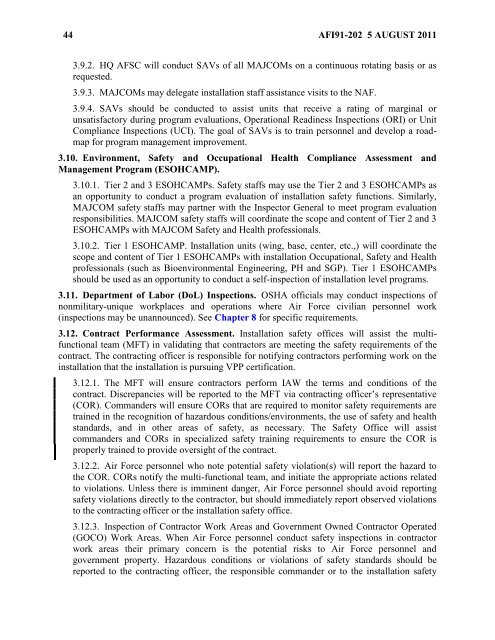MEMORANDUM FOR A1 - Air Force E-Publishing
MEMORANDUM FOR A1 - Air Force E-Publishing
MEMORANDUM FOR A1 - Air Force E-Publishing
Create successful ePaper yourself
Turn your PDF publications into a flip-book with our unique Google optimized e-Paper software.
44 AFI91-202 5 AUGUST 2011<br />
3.9.2. HQ AFSC will conduct SAVs of all MAJCOMs on a continuous rotating basis or as<br />
requested.<br />
3.9.3. MAJCOMs may delegate installation staff assistance visits to the NAF.<br />
3.9.4. SAVs should be conducted to assist units that receive a rating of marginal or<br />
unsatisfactory during program evaluations, Operational Readiness Inspections (ORI) or Unit<br />
Compliance Inspections (UCI). The goal of SAVs is to train personnel and develop a roadmap<br />
for program management improvement.<br />
3.10. Environment, Safety and Occupational Health Compliance Assessment and<br />
Management Program (ESOHCAMP).<br />
3.10.1. Tier 2 and 3 ESOHCAMPs. Safety staffs may use the Tier 2 and 3 ESOHCAMPs as<br />
an opportunity to conduct a program evaluation of installation safety functions. Similarly,<br />
MAJCOM safety staffs may partner with the Inspector General to meet program evaluation<br />
responsibilities. MAJCOM safety staffs will coordinate the scope and content of Tier 2 and 3<br />
ESOHCAMPs with MAJCOM Safety and Health professionals.<br />
3.10.2. Tier 1 ESOHCAMP. Installation units (wing, base, center, etc.,) will coordinate the<br />
scope and content of Tier 1 ESOHCAMPs with installation Occupational, Safety and Health<br />
professionals (such as Bioenvironmental Engineering, PH and SGP). Tier 1 ESOHCAMPs<br />
should be used as an opportunity to conduct a self-inspection of installation level programs.<br />
3.11. Department of Labor (DoL) Inspections. OSHA officials may conduct inspections of<br />
nonmilitary-unique workplaces and operations where <strong>Air</strong> <strong>Force</strong> civilian personnel work<br />
(inspections may be unannounced). See Chapter 8 for specific requirements.<br />
3.12. Contract Performance Assessment. Installation safety offices will assist the multifunctional<br />
team (MFT) in validating that contractors are meeting the safety requirements of the<br />
contract. The contracting officer is responsible for notifying contractors performing work on the<br />
installation that the installation is pursuing VPP certification.<br />
3.12.1. The MFT will ensure contractors perform IAW the terms and conditions of the<br />
contract. Discrepancies will be reported to the MFT via contracting officer’s representative<br />
(COR). Commanders will ensure CORs that are required to monitor safety requirements are<br />
trained in the recognition of hazardous conditions/environments, the use of safety and health<br />
standards, and in other areas of safety, as necessary. The Safety Office will assist<br />
commanders and CORs in specialized safety training requirements to ensure the COR is<br />
properly trained to provide oversight of the contract.<br />
3.12.2. <strong>Air</strong> <strong>Force</strong> personnel who note potential safety violation(s) will report the hazard to<br />
the COR. CORs notify the multi-functional team, and initiate the appropriate actions related<br />
to violations. Unless there is imminent danger, <strong>Air</strong> <strong>Force</strong> personnel should avoid reporting<br />
safety violations directly to the contractor, but should immediately report observed violations<br />
to the contracting officer or the installation safety office.<br />
3.12.3. Inspection of Contractor Work Areas and Government Owned Contractor Operated<br />
(GOCO) Work Areas. When <strong>Air</strong> <strong>Force</strong> personnel conduct safety inspections in contractor<br />
work areas their primary concern is the potential risks to <strong>Air</strong> <strong>Force</strong> personnel and<br />
government property. Hazardous conditions or violations of safety standards should be<br />
reported to the contracting officer, the responsible commander or to the installation safety
















